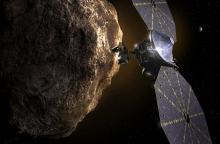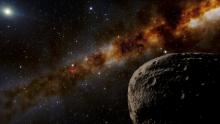Listen to today's episode of StarDate on the web the same day it airs in high-quality streaming audio without any extra ads or announcements. Choose a $8 one-month pass, or listen every day for a year for just $30.
You are here
The Dominator
The Sun exerts a mighty influence on the space around it. Our star holds on to eight major planets, perhaps hundreds of dwarf planets, and a trillion or more smaller chunks of rock and ice.
The key to this domination is the Sun’s mass. The Sun contains 99.9 percent of all the material in the solar system — more than 300,000 times the mass of Earth.
That great heft generates a powerful gravitational pull. In fact, the Sun’s gravity dominates a “bubble” of space that spans more than two light-years.
The most obvious members of the Sun’s family are Earth and the other major planets. The most distant of those is Neptune, 30 times farther from the Sun than Earth is. At that range, the Sun’s pull is only about one-tenth of one percent as strong as at Earth. Yet that’s plenty strong to hold Neptune in place.
Beyond Neptune is the Kuiper Belt — a doughnut-shaped region that contains millions of objects, including Pluto and many other dwarf planets.
The Sun’s influence doesn’t end there, though. It reaches all the way to the Oort Cloud — a shell of mountain-sized iceballs. The cloud may extend more than one light-year in every direction.
At that distance, an object barely “feels” the Sun’s pull — it’s only about one four-billionths as strong as at Earth. Unless another star wanders close by, though, that tiny pull holds objects in the Oort Cloud in orbit — extending the Sun’s dominance deep into space.
Script by Damond Benningfield






